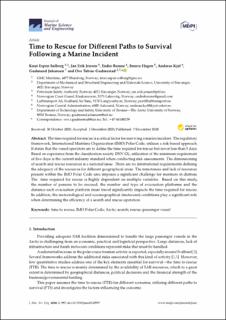| dc.contributor.author | Solberg, Knut Espen | |
| dc.contributor.author | Jensen, Jan Erik | |
| dc.contributor.author | Barane, Endre | |
| dc.contributor.author | Hagen, Snorre | |
| dc.contributor.author | Kjøl, Andreas | |
| dc.contributor.author | Johansen, Gudmund | |
| dc.contributor.author | Gudmestad, Ove Tobias | |
| dc.date.accessioned | 2021-05-02T18:52:13Z | |
| dc.date.available | 2021-05-02T18:52:13Z | |
| dc.date.created | 2020-12-07T12:35:18Z | |
| dc.date.issued | 2020-12 | |
| dc.identifier.citation | Solberg, K.E.., Jensen, J.E:, Barane, E. et al. (2020) Time to Rescue for Different Paths to Survival Following a Marine Incident. Journal of Marine Science and Engineering, 8 (12) | en_US |
| dc.identifier.issn | 2077-1312 | |
| dc.identifier.uri | https://hdl.handle.net/11250/2740683 | |
| dc.description.abstract | The time required for rescue is a critical factor for surviving a marine incident. The regulatory framework, International Maritime Organization (IMO) Polar Code, utilizes a risk-based approach. It states that the vessel operators are to define the time required for rescue but never less than 5 days. Based on experience from the classification society DNV GL, utilization of the minimum requirement of five days is the current industry standard when conducting risk assessments. The dimensioning of search and rescue resources is a national issue. There are no international requirements defining the adequacy of the resources for different geographical areas. The remoteness and lack of resources present within the IMO Polar Code area imposes a significant challenge for mariners in distress. The time required for rescue is highly dependent on multiple variables. Based on this study, the number of persons to be rescued, the number and type of evacuation platforms and the distance each evacuation platform must travel significantly impacts the time required for rescue. In addition, the meteorological and oceanographical (metocean) conditions play a significant role when determining the efficiency of a search and rescue operation. | en_US |
| dc.language.iso | eng | en_US |
| dc.publisher | MDPI | en_US |
| dc.rights | Navngivelse 4.0 Internasjonal | * |
| dc.rights.uri | http://creativecommons.org/licenses/by/4.0/deed.no | * |
| dc.subject | redning | en_US |
| dc.subject | Arktis | en_US |
| dc.title | Time to Rescue for Different Paths to Survival Following a Marine Incident | en_US |
| dc.type | Peer reviewed | en_US |
| dc.type | Journal article | en_US |
| dc.description.version | publishedVersion | en_US |
| dc.rights.holder | © 2020 by the authors. | en_US |
| dc.subject.nsi | VDP::Teknologi: 500::Marin teknologi: 580 | en_US |
| dc.source.pagenumber | 16 | en_US |
| dc.source.volume | 8 | en_US |
| dc.source.journal | Journal of Marine Science and Engineering | en_US |
| dc.source.issue | 12 | en_US |
| dc.identifier.doi | 10.3390/jmse8120997 | |
| dc.identifier.cristin | 1856907 | |
| dc.source.articlenumber | 997 | en_US |
| cristin.ispublished | true | |
| cristin.fulltext | original | |
| cristin.qualitycode | 1 | |

